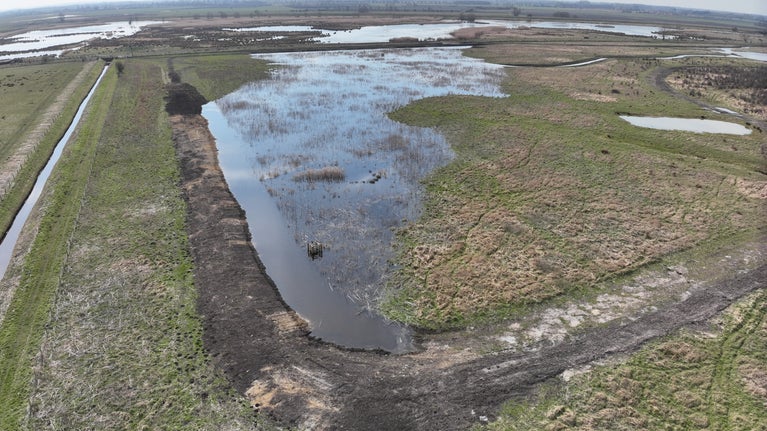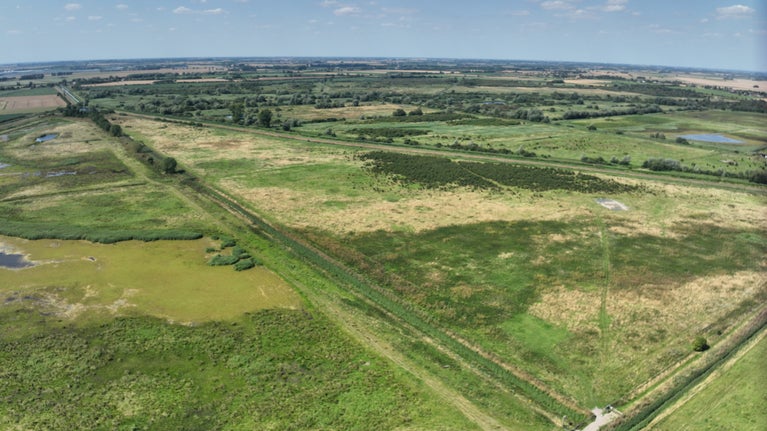Completion of Wicken Fen peatland restoration project provides hope for the future and sheds light on the past
- Published:
- 10 July 2025

The National Trust has completed an ambitious peatland restoration project at Wicken Fen in Cambridgeshire, securing a hopeful future for this vital landscape and the wildlife it supports. Spanning 215 hectares of lowland peat, the restoration marks a major step forward in tackling biodiversity loss and climate change.
Peatlands, like those at Wicken Fen, store more carbon than all the world's forests combined. But, when drained or degraded, they release this carbon into the atmosphere. By restoring these landscapes, the conservation charity is helping to preserve precious habitat, mitigate against climate change, enhance flood resilience, reduce wildfire risk and safeguard future water availability.
The project has been made possible thanks to primary funding from the Nature for Climate Peatland Grant Scheme managed by Fens East Peat Partnership with additional funding from philanthropic donors and corporate partners including Starling Bank and Anglian Water.
Various works have taken place across the nature reserve over the past six months. One significant task involved protecting a precious area of undrained Fen habitat from drying out due to water escaping through a perimeter boundary known as Spinney Bank. A waterproof liner has been installed across 300 metres of the bank to retain moisture in the peat. At the same time, encroaching scrub was cleared to restore the open fen landscape, further helping to keep the peat wet and lock carbon in the soil.
Emma Ormond-Bones, General Manager at Wicken Fen, said: “Nature is declining at an alarming rate, and the climate crisis is placing unprecedented pressure on the places and species we care about.
“This project is a huge achievement for the National Trust and a powerful step forward in the restoration of our natural world. It’s providing the space and conditions nature needs to recover, while also helping to store carbon and make landscapes more resilient to future environmental challenges.”
Part of the project focused on Burwell Fen, reclaimed for agriculture during the Second World War and acquired by the National Trust in 2001. Though drained and degraded, an area of deep peat remained where an extinct ancient river once flowed. A clay bund was constructed around this area, allowing it to be re-wetted. Although full transition back to fen habitat will take time, the impact has already been visible: rare wetland birds such as cranes and great egrets appeared within hours of the water level being raised. Other notable birds recorded on Burwell Fen this May include spoonbill and wading birds such as curlew and a pair of little ringed plovers.
Ellis Selway, Peatland Restoration Project Manager, commented: “Watching cranes arrive so soon after we raised the water was a moment I won’t forget. It made all the effort and planning worthwhile. These birds are a sign that wetland life is returning, and fast. Seeing nature respond so quickly gives us real hope for the future of this landscape.”
New solar-powered pumps are now helping to manage water levels sustainably, while a monitoring programme led by the UK Centre for Ecology and Hydrology will assess water quality, hydrology and greenhouse gas emissions into the future.
In a fascinating twist, the restoration works also revealed a significant archaeological discovery. A bog oak unearthed from the peat at Spinney Bank has been precisely dated by the Cambridge Archaeological Unit using tree-ring analysis. The results show the oak began growing in 2894 BC, lived for 222 years, pre-dating the start of peat formation, and links the site to a dry Late Neolithic woodland. This find is older than the stones at Stonehenge and the Ring of Brodgar.

Mark Knight, from Cambridge Archaeological Unit, said: “This discovery exemplifies that wonderful relationship between depth and time, which comes with exploring the peat fen. Traces of past landscapes abound beneath its surface, and what’s more, they come beautifully preserved and in clear chronological order."
Ellis Selway added: “Peat holds more than just carbon, it holds stories. Discovering a tree that took root nearly 5,000 years ago is a humbling reminder of how much history is preserved in these ancient landscapes. This kind of insight deepens our appreciation of what peatlands can teach us about the past, even as we look to restore them for the future.”
Further finds at Spinney Bank range from a locally made 20th-century lemonade bottle to the base of a 19th-century windpump – and even what was initially believed to be a cannonball from the English Civil War but is more likely a rollerball from the windpump – revealing layers of both natural and human history.
Caroline Thorogood, Senior National Consultant on peatlands at the National Trust said: “We care for 25,000 hectares of precious peatlands across England, Wales and Northern Ireland. Sadly, many of our peatlands – around 70% - are not in a healthy, natural condition, having faced pressures such as drainage and pollution. We are therefore working hard to recover and rejuvenate our peatlands for the future.
“The project at Wicken Fen is returning our most significant area of lowland peat to a wetter, more nature rich landscape that is good for people and wildlife. Excitingly, whilst making this iconic nature reserve more resilient in the future, the project has also given us a fascinating glimpse into the past.”
To find out more about the project and its lasting impact, visit the Peatland Restoration Project website.
